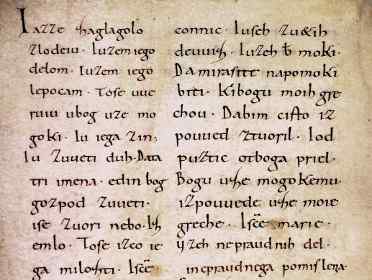Carolingian - Caroline Minuscule

Development and Importance of Carolingian Minuscule
Carolingian or Caroline minuscule is a script which was developed during the Carolingian Renaissance in the late 8th century and a writing standard in Europe until the end of the 12th century. The script was one of the greatest achievements of the cultural and intellectual revival under the Carolingian dynasty and survived until nowadays in a modified version. It was used as a model for Humanist minuscule which in turn served as a basis for the lowercase letters of modern typefaces. Carolingian minuscule and support of Charlemagne (768-814) and his immediate successors to learning also proved to be crucial for preservation of ancient knowledge as the oldest surviving classical works are mostly Carolingian copies from the 8th and 9th centuries.
Early Medieval Scripts
Carolingian minuscule was created by monastic scribes in scriptoria (rooms in medieval monasteries that were used for book copying) in the late 8th century. By that time, a variety of scripts that were used after the fall of the Western Roman Empire became extremely difficult to read. The earliest scripts in medieval Europe were derived from old Roman cursive, a majuscule script but there were several variants with no space between the words, no lowercase letters nor punctuations. The need for uniform and more legible script was also recognized by Alciun of York (c. 735-804) who led the Charlemagne’s palace school at Aachen from where Carolingian minuscule was first disseminated.
Characteristics of Carolingian Minuscule
The new script was greatly influenced by Roman half uncial and Roman cursive which in turn derived from Roman capital letters. It differentiated itself from the earliest medieval scripts by introduction of the lowercase letters that were rounded, wide and uniform but by above all - legibility because it also introduced word separation and punctuations including comma and the question mark. In fact, it resembled a hand print rather than cursive writing which made it ideal for manuscript copying. Capital letters were reserved for headings, beginning of new sentences and initials that were often decorated. Abbreviations were kept to the minimum and became standardized.
Spread and Revival in the 14th Century
Carolingian script spread throughout the Carolingian Empire and beyond its borders during the Carolingian Renaissance and remained in use for three centuries after the disintegration of Charlemagne’s empire at the end of the 9th century. It changed over time becoming more formal and uniform in compare to the older version. Carolingian minuscule developed into Gothic script, also known as blackletter in the 13th century but it was revived by the Italian humanists already in the 14th century.




